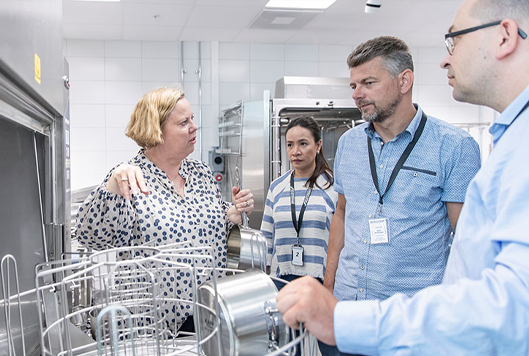Are you sanitising or just cleaning?
Learn the difference.
Cleaning is not enough to maintain a hygienic result in the kitchen. Proper sanitizing is needed in order to achieve it! Which one are you doing? Learn the difference.
Cleaning is not enough to maintain a hygienic result in the kitchen. Proper sanitizing is needed in order to achieve it! Which one are you doing? Learn the difference.
Most likely, we don't have to lecture you about the importance of sanitised washing results. We're also pretty sure that you already know that contaminated equipment is a big risk when handling food and that exposing your customers and guests to pathogenic bacteria can lead to both stomach ache and food poisoning - or in the worst case: death.
So, despite all of this knowledge - how come manually washing pots and pans in a sink is still so common? They soak, scrub, and clean. Do you get sanitised results by doing so? The answer is without a doubt NO.
– It’s impossible to sanitise pots and pans in a manual process, as the high temperatures needed to do so would be too hot for a human to handle. The wash water temperature in a sink is generally low, often around 40-45 °C, which is not nearly enough for full sanitization. Bacteria and microorganisms survive in temperatures ranging from -2 to +60 °C, says Ulrika AHNFELT GRAN, Product Manager at Nor:disk and continues:
– Some spores can even survive in boiling water. Bacteria love warm and moist environments full of food scraps. Also, most microorganisms thrive at a neutral pH, and sink detergent holds a pH of 6-8. This means that bacteria can survive in sinks for more than 6 hours. So a "cleaned" but not sanitised pot is really contaminated and could transfer potentially dangerous bacteria over to freshly produced food – in cases where the food it's not heated up to 100 degrees.
Most microorganisms thrive at a neutral pH, and that is why bacteria can survive in sinks for more than 6 hours.

Question
So, what do you need to sanitise your wash ware?
Answer
First, you need to stop manual washing in sinks. To get safe results, you need a machine that uses high temperatures and alkaline detergent - i.e. a pH of around 11. After sanitising your pots, be mindful - drying them with paper or a towel will contaminate them all over again. Instead, use a drying agent in the rinse water to get the wash ware dry.
– When deciding to invest in a new ware washing solution, make sure that it follows hygiene guidelines: DIN 10512 and/or NSF/ANSI-3 requirements. Then you can be sure that your solution provides high enough temperatures (wash temp around 65 degrees and rinse temp of at least 85 degrees) to sanitise your wash ware properly, says Ulrika AHNFELT GRAN.
Question
Do you have some other tips for maintaining and achieving sanitized results?
Answer
– It’s important to serve for good personal hygiene among the staff - such as washing hands - to make sure that the wash ware isn't contaminated after sanitization. Also, keep the line of incoming dirty wares clearly separated from the clean wash ware.
Since Nor:disk started in the late '80s, one of our core missions has been to provide sanitised and clean wash ware to our customers. Having met millions of customers in the commercial kitchen industry world-wide, week after week, year after year, we’ve gathered a lot of knowledge about safe washing results. We'd love to share our knowledge and learnings with you.
Book a free demo →